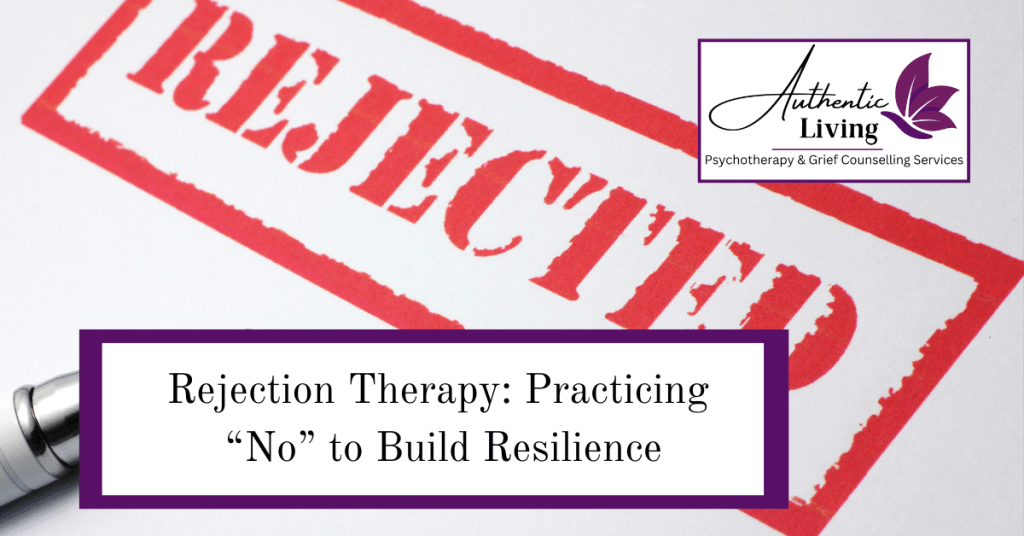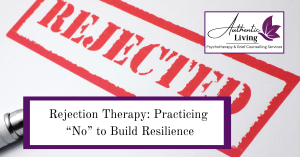Most of us go to great lengths to avoid rejection. And for good reason—being told “no” can stir up a lot: shame, self-doubt, embarrassment, even a desire to disappear. But what if, instead of dodging rejection, we practiced letting it in—on purpose?
Rejection Therapy is a surprisingly powerful way to build emotional resilience, soften our fear of judgment, and expand the range of what we believe we can handle. In this post, we’ll explore what rejection therapy is, why it works, and how you might begin to use it in your own life—gently, curiously, and at your own pace.
What Is Rejection Therapy?
Rejection therapy is exactly what it sounds like: intentionally putting yourself in situations where you might be rejected—not to fail, but to grow. The idea is to make peace with the discomfort of hearing “no” and to remind yourself that rejection doesn’t say anything about your worth.
This approach was first introduced by Jason Comely, a Canadian entrepreneur who created it as a way to heal his own fear of social rejection. It has since taken off as both a therapeutic tool and a personal experiment in courage.
Why Does Rejection Sting So Much?
If rejection feels unusually painful, you’re not imagining it. Neuroscience shows that our brains process rejection much like physical pain. From an evolutionary standpoint, being cast out of the group once meant real danger—so our nervous systems react strongly to anything that might resemble exclusion.
That might sound dramatic, but it shows up in very human ways. You might:
Avoid asking for help, even when you need it
Hold back your opinions or desires to avoid rocking the boat
Feel devastated when someone unfollows you, ghosts you, or critiques your work
Say “yes” when you want to say “no” because you’re afraid of conflict
Rejection therapy doesn’t promise to eliminate this pain, but it does help you learn how to stay present with it without shrinking.
What Makes Rejection Therapy So Effective?
At its core, rejection therapy is a type of exposure work. You’re gradually showing your nervous system that you can handle discomfort—and that what you fear might not be as dangerous as it once felt.
It does a few important things:
Normalizes “no” as a neutral response instead of a personal failure
Builds emotional tolerance for uncomfortable feelings
Rewires old beliefs like “If I’m rejected, I must have done something wrong”
Encourages curiosity over avoidance, which opens the door to growth
What Does 'Practicing Rejection' Build Over Time?
Confidence
The more you practice hearing “no,” the less terrifying it becomes. Over time, your confidence builds—not because you’re getting more yeses, but because you’re showing up for yourself even when you don’t.
Resilience
Rejection therapy doesn’t just toughen you up; it softens your fear. You start to realize you can recover from rejection, and that makes it easier to try again.
Clarity
Practicing rejection often clarifies your values. You ask for what you truly want—not what you think is safest. That’s a powerful shift.
Boundaries
You also get more comfortable saying “no” to others. When you’re no longer afraid of being rejected yourself, it becomes easier to honour your own limits.
How to Try Rejection Therapy (Without Overwhelming Yourself)
You don’t need to jump into the deep end. Like anything related to healing or personal growth, this is best done gently and with self-awareness.
Step 1: Set Your Intention and Start Small
Instead of “toughening up,” try approaching asking with curiosity. What happens if you let yourself be seen, even when the outcome is uncertain?
Start small:
• Ask for a book recommendation
• Ask a store about discounts (even if they don’t apply)
• Ask a friend for help with something you usually do alone
Step 2: Reflect After Each Attempt
Pause and ask:
How did that feel in my body?
What did I tell myself about their “no”?
What surprised me about that experience?
You’re not just collecting rejections. You’re collecting self-awareness.
Step 3: Work Your Way Up
As your tolerance grows, you might move toward asks that feel a bit more vulnerable:
Asking for feedback
Setting a boundary you’ve been avoiding
Reaching out to someone you’d like to reconnect with
Pitching your work, your idea, or even yourself
30 Days of Rejection Practice (If You Want a Challenge)
Here’s a month’s worth of gentle but stretching asks you can try. Modify them to fit your context and comfort level.
Ask someone to recommend a podcast.
Ask a shop if they can give you something for free.
Ask a friend if they’ll drive you somewhere.
Ask for help carrying something.
Ask someone to take your photo in public.
Ask to test a product without buying it.
Ask a stranger for directions (even if you don’t need them).
Ask someone you admire for a coffee chat.
Ask to skip the line.
Ask a friend to be honest about something you made.
Ask for an upgrade (at a hotel, café, etc.).
Ask a colleague for their honest opinion.
Ask someone to share a story about rejection with you.
Ask for a referral or recommendation.
Ask someone to join you for something spontaneous.
Ask your boss or coworker for more responsibility.
Ask a therapist or mentor for advice you’ve been avoiding.
Ask someone if they want to collaborate.
Ask someone to try something new with you.
Ask your partner for something more emotionally intimate.
Ask for help in a store—even if you feel like you “should” know.
Ask a past client for a testimonial.
Ask to volunteer for something you feel unqualified for.
Ask someone to tell you what they think your strengths are.
Ask for a loan or extension—if it’s needed.
Ask someone to go somewhere you’ve wanted to explore.
Ask for constructive criticism.
Ask someone to set a boundary with you if they need one.
Ask a local business if they’d post your flyer.
Ask yourself: “What would I ask for if I weren’t afraid of ‘no’?”
A Few Things to Keep in Mind: Final Thoughts
Rejection isn’t proof that you’re unworthy—it’s often a reflection of someone else’s capacity, timing, or needs. Still, we know it can hurt. Deeply.
You’re allowed to take your time. Healing doesn’t mean rushing through discomfort or pretending you’re fine. You don’t have to force connection or hide your pain. Start where you are—with compassion, not pressure.
If rejection brings up deep shame, trauma, or emotional pain, therapy can help. At Authentic Living London, our team of caring, trauma-informed therapists creates a safe space to explore what’s beneath the surface—whether it’s past wounds, fear of being seen, or the exhausting cycle of self-doubt.
You don’t have to carry this alone.
We’re here to support your healing, at your pace.
Book with us today!

Lizanne Hills
Registered Psychotherapist -Qualifying Addictions Certificate
Areas of Focus: Grief, Addictions, Family Therapy, Couples Therapy, Trauma/PTSD, Children’s Grief, Autism Spectrum Disorder, Life Transitions





